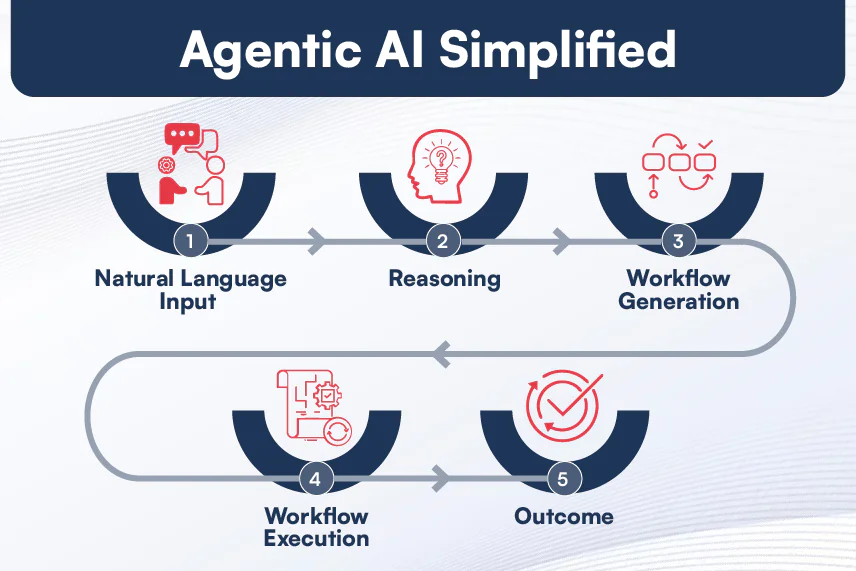
Table of Contents
What are AI Agents?
AI agents are software programs that utilize AI to perceive and interact with their environment, gather and process data, and take actions independently to achieve specific objectives. There are six key components of AI agents: sensor, actuator, perception module, decision-making mechanism, cognitive architecture, and learning or knowledge base systems.
AI agents operate based on pre-defined rules, learned patterns, or adaptive algorithms. With their data and perceptions, these AI assistants make logical decisions to deliver optimal results and performance. Interestingly, they can improve their performance over time through experience and additional data.
AI agents are autonomous entities that perform tasks or solve problems on behalf of users. Equipped with AI-driven capabilities, they can learn from interactions, process data, and make decisions with minimal human intervention. By simulating human behavior and cognition, they are transforming the way businesses operate, automate processes, and derive insights from complex data environments.
When implementing AI agents, it’s critical to prepare high-quality structured data, choose the right AI agent type, focus on UX, ensure seamless integration with existing systems, monitor the performance of AI agents, prioritize data privacy and security, and plan for human intervention when necessary.
Types of AI Agents
AI agents vary depending upon their capabilities. Here are five different types of AI agents that organizations can build and deploy.
Simple Reflex Agents: As the name suggests, these are non-complex AI agents which are best suited for uncomplicated tasks that don’t need rigorous training. They are pre-programmed to function only based on predefined reflexes and don’t communicate with other AI agents if they miss any data. In case of unforeseen situations, they lack the ability to deliver an appropriate response.
Goal-Based Agents: These are complex AI agents that have robust reasoning and decision-making capabilities. They select the most efficient path and compare multiple approaches to reach the desired goals. They consider and plan their actions beforehand, in addition to searching for the right action sequences. Compared to model-based or simple reflex AI agents, they are usually considered more efficient.
Model-Based Agents: This type of AI agent can maintain an internal model of the world it perceives. It is more agile than simplex reflex AI agents and can function in partially observable or dynamic environments. Based on its understanding of context, it can make autonomous decisions. However, it carefully evaluates probable outcomes and consequences before making a decision.
Learning Agents: These AI agents have a unique ability to learn. They can adapt their learning element to attain specific standards by leveraging feedback mechanisms and sensory input. The autonomous acquisition of new experiences enhances their knowledge base. This enables them to function effectively in unfamiliar environments as their learning evolves. Learning, problem generator, performance, and critic are the four key elements of learning AI agents.
Utility-Based Agents: This AI agent works best in scenarios where multiple approaches are available to solve a problem, but the most optimal solution needs to be selected. It utilizes a complex reasoning algorithm and compares different scenarios and respective utility values to maximize the desired outcome. The four key components of utility-based AI agents are environment model, decision mechanism, state evaluation, and utility function.
Examples of AI Agents
The application of AI agents in business is vast, ranging from customer service automation to advanced data analysis and decision-making. Here are some prominent examples of AI agents:
1. Intelligent Task Automation for Enhanced Operational Efficiency
AI agents can significantly improve organizational efficiency by automating routine tasks such as scheduling meetings, processing invoices, and managing workflows. These AI assistants possess the ability to intelligently prioritize tasks based on various factors, including urgency, deadlines, and contextual relevance.
For instance, AI agents might analyze payment terms and vendor relationships to determine which invoices require immediate attention. This can help ensure timely payments and maintain positive supplier relations. By leveraging data and contextual insights, AI agents not only streamline operations but also improve decision-making, allowing teams to allot their time and resources more effectively for strategic initiatives that drive business growth.
2. Compliance Regulation Alignment with Autonomous Workflow
Consider a US-based company expanding into Europe that needs to ensure its data handling processes comply with GDPR regulations. Manually, compliance officers would need to:
- Gather US privacy policies and GDPR documents
- Compare the two for discrepancies
- Conduct a gap analysis
- Work with IT to update practices and ensure compliance
With an AI intelligent agent-based approach, a single query—such as “Align our current US data handling processes with European GDPR regulations and recommend changes.”—triggers the agent to retrieve the necessary documents, compare them, identify gaps, recommend changes, and automatically apply updates to ensure compliance. This in turn streamlines a complex, multi-step process into an efficient and autonomous workflow.
3. Dynamic Analytics Tool Selection for Strategic Insights
AI agents can intelligently assess the analytical requirements of a business and automatically choose the most suitable tools and methods for analysis. For instance, consider a company that wants to understand the increase in sales and revenue from last year.
In this case, AI agents can select appropriate metrics, such as year-over-year growth, and determine whether to use time-series analysis, regression models, or comparative dashboards.
Agentic AI Success Stories Crafted by Harbinger
Success Story #1: Process Flow Training Content Creation for Global Subsidiaries
Harbinger has developed innovative Retrieval-Augmented Generation (RAG) solutions that intelligently interact with multiple data sources, processes, and tools to automate complex business tasks.
Project
A flagship project involved automating the development of training content for a multinational manufacturing company, using its Japanese subsidiary’s highly effective process flow to train employees at its American subsidiary.
Solution
Data Sources: AI agents connect to both structured and unstructured data sources, retrieving the Japanese subsidiary’s process flow documents from internal databases and document repositories.
Intelligent Query Handling: AI agents detect the language of the documents (in this case, Japanese), intelligently sourcing from Harbinger’s iTranslate tool for language translation while ensuring the accuracy of technical terms and processes.
Content Authoring: The translated content is automatically structured using Harbinger’s Storyboard tool. This tool generates detailed training materials, including flowcharts and process diagrams. AI agents tailor the content to the specific needs of the American subsidiary’s training framework.
Cross-System Interoperability: By accessing multiple internal data systems and tools such as iTranslate and Storyboard, AI agents ensure seamless translation, content creation, and delivery to the LMS.
Result
Harbinger’s solution has significantly reduced the time and effort required to convert foreign-language process documents into actionable training materials. This has allowed the American subsidiary to rapidly adopt and implement the successful practices of its Japanese counterpart. Furthermore, the use of AI-powered RAG and cross-system tools has provided the company with an efficient, scalable, and intelligent method for knowledge transfer across its global operations.
Success Story #2 How AI Agents Automated Custom Leadership Coaching and Analysis for Global Skilling Platform
Business Need
A global skilling platform sought to advance their leadership development planning and analysis process. They wanted to deliver personalized coaching to leaders and enable efficient content retrieval. They were looking for an automated solution to evaluate and classify executive behaviors, discover leadership patterns, and boost leadership performance.
Solution
Harbinger built a Conversational AI platform with RAG and Agentic framework to create automated leadership coaching and development plans. It connected AI agents to an extensive repository of coaching content. AI agents efficiently selected from a wide range of sources and applied the RAG approach to generate precise, tailored recommendations and insights for leadership development.
Below are the key features of Harbinger’s Conversational AI platform supported by RAG and Agentic framework:
Comprehensive Data Collection and Analysis
- Automated data gathering
- Data reliability and logging
Deep Behavioral Insights
- Analysis of subtle behavioral nuances
- Pattern recognition and measurable outcomes
Personalized Development Plans
- Targeted leadership improvement
- Strengths-based coaching approach
The overall system architecture discovered leadership and their communication patterns, analyzed their behaviors, and classified them into specific categories to provide custom coaching plans. It improved coaching precision and streamlined processes for planners and principal scientists.
Result
The Conversational AI platform powered by RAG and Agentic AI helped with 50% faster discovery of relevant content for coaching planners. It reduced the manual efforts required for coaching plan creation by 30% and delivered a 20-hour monthly time saving with automated content retrieval.
Furthermore, the conversational flexibility of AI agents enabled optimal and personalized leadership development. Custom executive training scalability and consistent assessments along with focused leadership coaching backed by data-driven insights were among other benefits. With the development of high-performing leaders, the client was able to achieve greater organizational success.
Explore Practical Applications of AI Agents
Agentic AI Frameworks: LangGraph and CrewAI

Harbinger’s approach to building AI agents is grounded in agentic frameworks. It ensures flexibility, scalability, and intelligence in agent design. Two of the well-known frameworks are:
LangGraph: It is a powerful framework for building stateful, multi-actor applications with LLMs. It provides an expressive and flexible way to define complex agent workflows, offering greater control and customization compared to other LLM frameworks.
Key features of LangGraph include:
- Cycles: Unlike DAG-based solutions, LangGraph supports cycles, making it suitable for most agentic architectures.
- Controllability: LangGraph provides fine-grained control over both the flow and state of your application, allowing you to build highly reliable agents.
- Persistence: LangGraph allows you to manage state and persistence within your agent applications, ensuring your agents maintain context and learn from their experiences.
LangGraph is a valuable tool for developers looking to build sophisticated AI agents and applications that can handle complex tasks and interactions.
CrewAI: It is a modular system designed for building, managing, and scaling agent-based solutions across industries. It offers a full stack of tools for agent orchestration, including robust logging, agent skill monitoring, and error handling.
Key features of CrewAI include:
- Modular Architecture: CrewAI allows agents to be equipped with specialized skills, enabling them to perform a range of tasks such as data retrieval, query interpretation, and contextual responses.
- Scalability: With built-in scalability features, CrewAI ensures agents are deployed in enterprise environments with high-demand and complex workflows.
- Real-Time Monitoring: CrewAI provides live feedback and monitoring tools that track agent performance, ensuring optimization and alignment with business goals.
Getting Started with AI Agents
AI agents are redefining business workflows and decision-making processes. Harbinger’s experience in developing RAG-based solutions and utilizing frameworks like LangGraph and Crew position it at the forefront of AI-driven transformation.
Harbinger’s intelligent AI automation agents are equipped to navigate multiple data sources and provide powerful insights. They empower businesses to operate more efficiently and make informed decisions in real-time. If you would like to learn more about intelligent agents in AI or discuss your agentic AI requirements, contact our experts.






